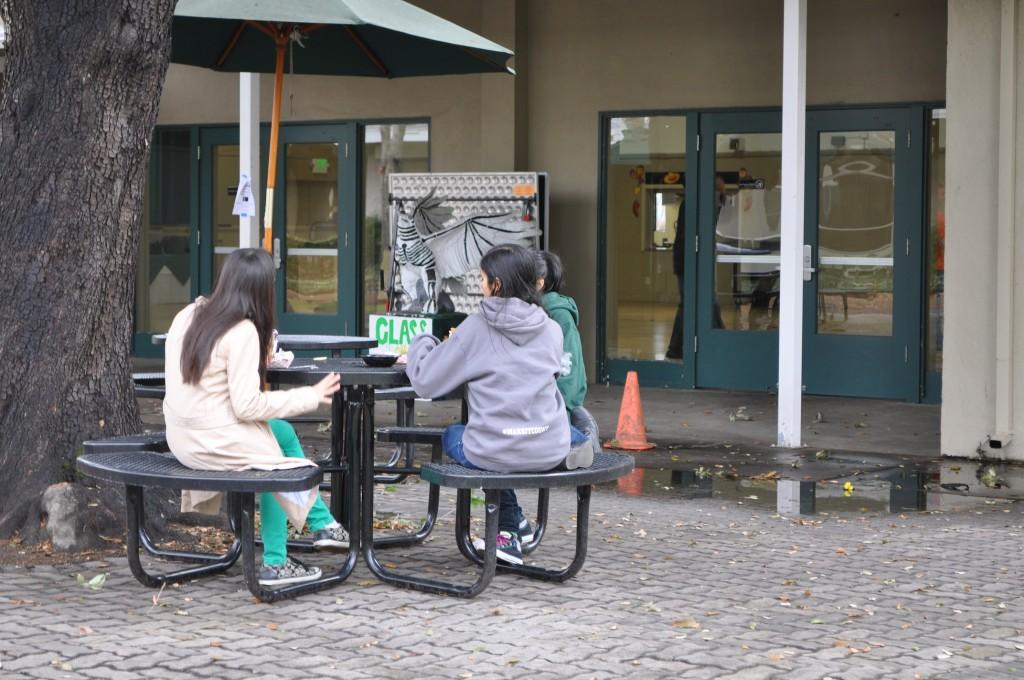Upper School campus experiences first week of continuous rainfall this season
A group of students sit outside in the Quad area during lunch next to a large puddle that formed from the rain in the morning. On campus, orange cones were set up around particularly large puddles and some flooded areas.
With the prolonged drought plaguing California during its wet season, the U.S. Drought Monitor considers more than 98 percent of the state to be abnormally dry.
The drought has caused a record dryness in California that may be worse than the one of 1976-77. Governor Jerry Brown has asked people to cut their water usage by 20 percent to combat the lack of precipitation and diminished snowpack. Some cities have begun prohibiting people from washing cars, watering their lawns during the daytime, and filling swim pools.
This week marks the first period of continual rain during the season. The average annual precipitation in San Jose is 14.9 inches, and January resulted in 2.99 inches of rainfall. Today is the first day that students have experienced rainfall, which reached an estimated 1.12 inches, during the school day. Rain until after first period, coupled with wind, led those on campus to rush inside to stay dry.
Due to the rainfall, animals that had remained hidden due to the dry environment, including salamanders and insects, made a small reappearance this week; earthworms moved above ground onto the asphalt and concrete this morning in response to the moisture.
Although the appearance of these animals were positive signs, the amount of rainfall so far is not enough to make up for the diminished levels of reservoirs.
“Literally, it’s a drop in the bucket for what we need. Getting an inch today is absolutely helpful, but we’re going to be in trouble this summer,” biology teacher Dr. Harley said. “We’re going to see major effects including things like price of fruits and vegetables, all sorts of things. California’s economy may be very different this year and next year.”
While some, like Dr. Harley, have been tracking the severity of the drought, others have not yet felt the urgency or effects of California’s situation. With water for daily use still available, many students do not feel affected by the reservoir levels’ drop below half capacity. Reservoirs dropped from a typical average of 64% capacity to 39% this year.
“I honestly don’t have a strong opinion on the drought because it is currently not directly affecting me, but I definitely think it’s a problem that needs to be addressed in order to avoid future problems,” Sharon Babu (12) said.
However, some also enjoyed the rain simply for what it was.
“It was a nice change in scenery, and it was nice to know that we aren’t in a completely dry season,” Harry Xu (11) said.
Forecasts expect approximately another inch of rain to continue tomorrow afternoon and over the weekend until late Sunday night.
Arden Hu, copy editor for the TALON Yearbook, is a senior and has been on staff for three years. She is also part of the varsity tennis team and enjoys...


















![“[Building nerf blasters] became this outlet of creativity for me that hasn't been matched by anything else. The process [of] making a build complete to your desire is such a painstakingly difficult process, but I've had to learn from [the skills needed from] soldering to proper painting. There's so many different options for everything, if you think about it, it exists. The best part is [that] if it doesn't exist, you can build it yourself," Ishaan Parate said.](https://harkeraquila.com/wp-content/uploads/2022/08/DSC_8149-900x604.jpg)




![“When I came into high school, I was ready to be a follower. But DECA was a game changer for me. It helped me overcome my fear of public speaking, and it's played such a major role in who I've become today. To be able to successfully lead a chapter of 150 students, an officer team and be one of the upperclassmen I once really admired is something I'm [really] proud of,” Anvitha Tummala ('21) said.](https://harkeraquila.com/wp-content/uploads/2021/07/Screen-Shot-2021-07-25-at-9.50.05-AM-900x594.png)







![“I think getting up in the morning and having a sense of purpose [is exciting]. I think without a certain amount of drive, life is kind of obsolete and mundane, and I think having that every single day is what makes each day unique and kind of makes life exciting,” Neymika Jain (12) said.](https://harkeraquila.com/wp-content/uploads/2017/06/Screen-Shot-2017-06-03-at-4.54.16-PM.png)








![“My slogan is ‘slow feet, don’t eat, and I’m hungry.’ You need to run fast to get where you are–you aren't going to get those championships if you aren't fast,” Angel Cervantes (12) said. “I want to do well in school on my tests and in track and win championships for my team. I live by that, [and] I can do that anywhere: in the classroom or on the field.”](https://harkeraquila.com/wp-content/uploads/2018/06/DSC5146-900x601.jpg)
![“[Volleyball has] taught me how to fall correctly, and another thing it taught is that you don’t have to be the best at something to be good at it. If you just hit the ball in a smart way, then it still scores points and you’re good at it. You could be a background player and still make a much bigger impact on the team than you would think,” Anya Gert (’20) said.](https://harkeraquila.com/wp-content/uploads/2020/06/AnnaGert_JinTuan_HoHPhotoEdited-600x900.jpeg)

![“I'm not nearly there yet, but [my confidence has] definitely been getting better since I was pretty shy and timid coming into Harker my freshman year. I know that there's a lot of people that are really confident in what they do, and I really admire them. Everyone's so driven and that has really pushed me to kind of try to find my own place in high school and be more confident,” Alyssa Huang (’20) said.](https://harkeraquila.com/wp-content/uploads/2020/06/AlyssaHuang_EmilyChen_HoHPhoto-900x749.jpeg)



